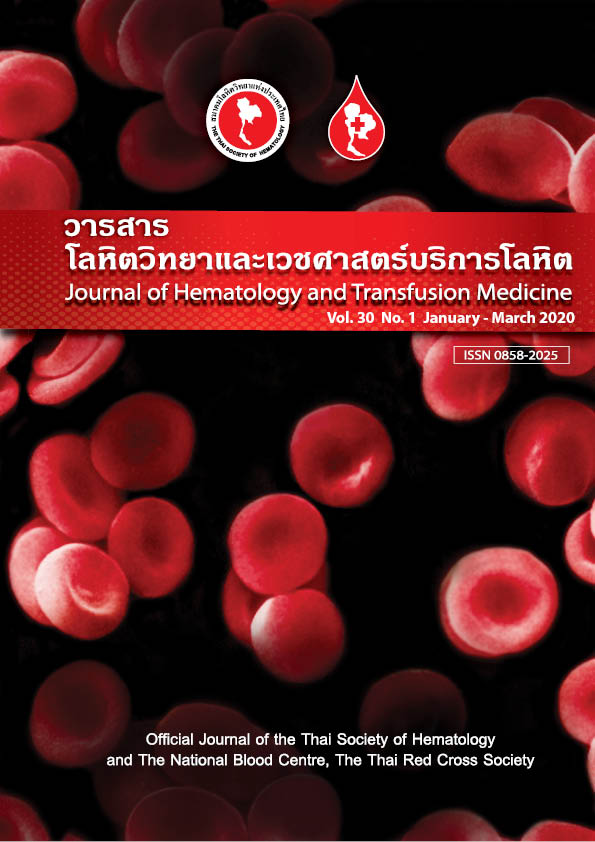ประเมินการจัดหาโลหิตแบบบูรณาการของ 5 จังหวัดในเขตภาคเหนือตอนล่าง และผลสัมฤทธิ์ของการจ่ายส่วนประกอบโลหิต ปี พ.ศ. 2561
Keywords:
Donor recruitment, Blood shortage, IntegrationAbstract
บทคัดย่อ
บทนำ ความไม่แน่นอนและข้อจำกัดของจำนวนการออกหน่วยเคลื่อนที่ในแต่ละจังหวัด ทำให้เกิดความไม่สม่ำเสมอของการจัดหาโลหิต และเกิดภาวะการขาดแคลนโลหิตบ่อยครั้ง ภาคบริการโลหิตแห่งชาติที่ 8 จังหวัดนครสวรรค์ ซึ่งดูแลพื้นที่ของ 5 จังหวัดในเขตภาคเหนือตอนล่าง จึงร่วมกับเหล่ากาชาดจังหวัดและโรงพยาบาลประจำจังหวัด ได้แก่ จังหวัดนครสวรรค์ อุทัยธานี พิจิตร ชัยนาท และเขตพื้นที่อำเภอเมือง วังเจ้า บ้านตาก และสามเงา ของจังหวัดตาก ในการบูรณาการด้านการจัดหาโลหิตของภูมิภาค เพื่อแก้ไขปัญหาดังกล่าว วัตถุประสงค์ เพื่อประเมินการจัดหาโลหิตของหน่วยเคลื่อนที่ ภายหลังการบูรณาการแผนของ 5 จังหวัด และประเมินผลสัมฤทธิ์การจ่ายส่วนประกอบโลหิตของภาคบริการโลหิตแห่งชาติที่ 8 จังหวัดนครสวรรค์ ให้กับโรงพยาบาลต่างๆ ในปี พ.ศ. 2561 วัสดุและวิธีการ จัดทำแผนบูรณาการโดยใช้ 3 กลยุทธ์ คือ การจัดทำแผนจัดหาโลหิตของภูมิภาคร่วมกับ การบริหารจัดการหน่วยเคลื่อนที่ และการประชาสัมพันธ์และรณรงค์จัดหาผู้บริจาคโลหิต เก็บข้อมูลการจัดหาโลหิต ร่วมกับการส่งตรวจคัดกรองโลหิตและการจ่ายส่วนประกอบโลหิตของภาคบริการโลหิตแห่งชาติที่ 8 จังหวัดนครสวรรค์ ให้กับโรงพยาบาลต่างๆ ในปี พ.ศ. 2561 ผลการศึกษา พบว่าปี พ.ศ. 2561 สามารถจัดหาโลหิตได้ 73,064 ยูนิต (ร้อยละ 3.01) ของจำนวนประชากรในพื้นที่ เป็นโลหิตที่ได้รับจากการบูรณาการหน่วยเคลื่อนที่ 49,353 ยูนิต (ร้อยละ 67.55) ของการจัดหาโลหิตทั้งหมด เพิ่มขึ้นเมื่อเปรียบเทียบกับก่อนการบูรณาการจัดหาโลหิตของหน่วยเคลื่อนที่ แต่ไม่พบความแตกต่างอย่างมีนัยสำคัญทางสถิติ (p > 0.05) จังหวัดนครสวรรค์สามารถจัดหาโลหิตจากหน่วยเคลื่อนที่ 346 หน่วย จาก 611 หน่วย และได้โลหิตมากที่สุด 23,852 ยูนิต (ร้อยละ 48.33) รองลงมา คือ จังหวัดพิจิตร ชัยนาท อุทัยธานี และเขตพื้นที่จังหวัดตาก จำนวน 10,561, 5,934, 5,709 และ 3,297 ยูนิต (ร้อยละ 21.4, 12.02, 11.57 และ 6.68) ตามลำดับ สำหรับการจ่ายส่วนประกอบโลหิตให้กับโรงพยาบาลในเขตพื้นที่รับผิดชอบ พบว่าสามารถจ่ายไครโอพรีซิปิเตทได้มากที่สุด (ร้อยละ 100) รองลงมาคือ เกล็ดเลือด พลาสมาแช่แข็ง และเม็ดเลือดแดง (ร้อยละ 99.38, 99.24 และ 85.76) ตามลำดับ และตรงกับความต้องการมากกว่าร้อยละ 80 ในทุกผลิตภัณฑ์ สรุป การจัดหาโลหิตโดยวิธีบูรณาการของ 5 จังหวัดในเขตภาคเหนือตอนล่างในปี พ.ศ. 2561 โลหิตที่ได้รับทั้งหมดในภูมิภาคที่ได้รับจากหน่วยเคลื่อนที่ ถึงแม้ว่ามีแนวโน้มเพิ่มขึ้นอย่างไม่มีนัยสำคัญทางสถิติ แต่แนวทางในการบูรณาการแผนยังคงต้องนำมาปรับปรุงและพัฒนาอย่างต่อเนื่อง เพื่อให้เกิดผลสัมฤทธิ์ในการนำไปใช้กำหนดเป็นนโยบายอย่างยั่งยืนต่อไป
Abstract:
Introduction: Uncertainty and limitation of number of mobile units in each province are the major causes of inconsistency blood procurement and frequent blood shortage. The Regional Blood Centre VIII, Nakhonsawan, Thai Red Cross Society in cooperation with the Provincial Red Cross Chapters and regional hospitals in the five lower-northern provinces of Thailand has integrated the provincial blood recruitment plan into the regional plan to help solving problems. Objective: To evaluate the number of blood procurement from mobile units after an integration of the five lower-northern provinces (Nakhonsawan, Uthaithani, Pichit, Chainat and Tak (Mueang, Wangchao, Samngao and Bantak district), including their blood component distributions to other hospitals within the Regional Blood Centre VIII, Nakhonsawan territory in the year 2018. Materials and methods: To investigate the number of blood procurement from mobile units and blood components delivery to other hospitals by analyzing the data of the blood procurement combined with laboratory testing and blood component distribution of the Regional Blood Centre VIII, Nakhonsawan in 2018. The three strategies of an integrated plan had been established as: the donor recruitment plan, the management of mobile units and the public relation and campaign. Results: The total number of blood procurement in 2018 was 73,064 units (3.01% of population in this area), which 49,353 units (67.55%) of total blood donation were collected from integration of mobile units. It was increased when compared to that of the previous years without integration program; however, there was no statistically significant difference (p
> 0.05). Nakhonsawan had the highest numbers of blood donation 23,812 units (48.33 %), followed by Pichit, Chainat, Uthaithani and some parts of Tak which were 10,561 (21.4%), 5,934 (12.02%), 5,709 (11.57%), and 3,297 units (6.68%), respectively and the 611 mobile blood drives were held in this year. For the distribution of blood components to other hospitals, it appeared that the distribution of cryoprecipitate, platelet product, fresh frozen plasma and red blood cells were 100, 99.38, 99.24 and 85.76%, respectively. Conclusion: The three strategies of the integration of blood recruitment was implemented in the five lower-northern provinces of Thailand revealed that 67.55% of total blood donation in this area was supported from mobile units with 100% voluntary non-remunerated blood donors. Of all blood components from the Regional Blood Centre VIII, Nakhonsawan were distributed directly to other hospitals in the responsible area in accordance with the need more than 80%. However, the continuous improvement of the integration plan will bring more success and sustainable outcome.
Downloads
References
2. Petchwong K. Strategies of donor recruitment of National Blood Centre, Thai Red Cross Society. J Hematol Transfus Med. 2009;19:149-56.
3. National Blood Centre, Thai Red Cross Society. National blood policy 2010. 1st ed. Bangkok: Udomsuksa; 2010.
4. Otto PE, Bolle F. Multiple facets of altruism and their influence on blood donation. J Socio Econ. 2011;40:558-63.
5. World Health Organization. Blood safety and availability [Internet]. 2019 [cited 2019 Jun 19]. Available from: https://www.who.int/news-room/fact-sheets/detail/blood-safety-and-availability
6. National Blood Centre, Thai Red Cross Society. Annual report 2018. Bangkok: Chulalongkorn University Printing House; 2019.
7. Department of Provincial Administration. Official statistics registration systems [Internet]. 2019 [cited 2019 Jun 11]. Available from: https://stat.dopa.go.th/stat/statnew/upstat_age.php
8. Lertpaisankul S, Srinopharatwatana W, Hentua P, Tedsomboon S, Suriyasawas S. The improving of blood donor recruitment in Nakhonsawan province, from 2013 to 2015. J Hematol Transfus Med. 2016;26:331-7.
9. National Blood Centre, Thai Red Cross Society. Blood donor selection guideline. 6th ed. Bangkok: Udomsuksa; 2017. 10. National Blood Centre, Thai Red Cross Society. The projects and activities for blood donors recruitment guideline in 2018. 1st ed. Bangkok: National Blood Centre; 2018.
11. Lertpaisankul S, Tedsomboon S. Prevalence of Syphilis, HIV, HBV and HCV infections among first time blood donors tested at the Regional Blood Center VIII, Nakhonsawan province, from 2007 to 2011. J Hematol Transfus Med. 2013;23:187-94.
12. Permpikul P, Outrakoolpoonsuk K, Jaiyen B, Pisuttiporn S, Chongkolwatana V. Determination of proper blood supply for Siriraj Hospital. J Hematol Transfus Med. 2007;17:115-22.



